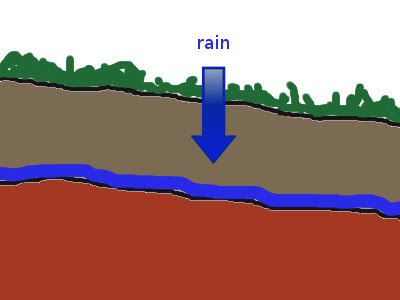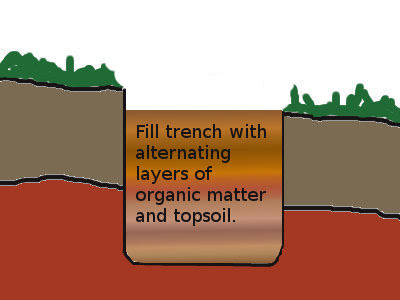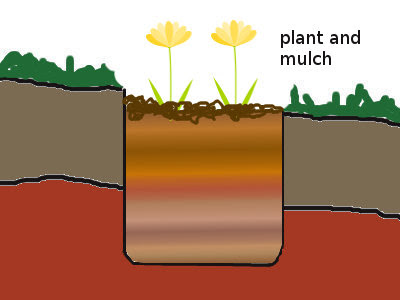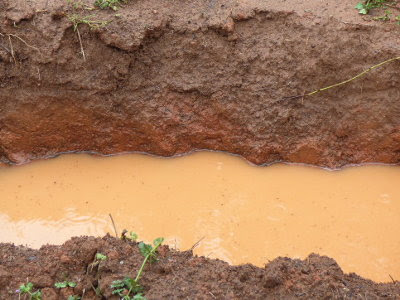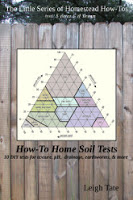

| Online: | |
| Visits: | |
| Stories: |

| Story Views | |
| Now: | |
| Last Hour: | |
| Last 24 Hours: | |
| Total: | |
Double Digging for Rainwater Collection
Last summer was a doozy in terms of too much heat and too little rain. If you’re a regular reader, than you know we’re working on additional measures to harvest more rainwater including a larger collection tank and garden swales (or humus beds as Sepp Holzer calls them). One day Geoff Lawton had a link in his newsletter to this page (second video down), and it got me thinking about double digging.
Double digging is a biodynamic (French intensive) soil preparation technique. No-till purists may frown, so I will be quick to point out that double digging is gentle on the land because it is done by hand. It is not a mechanical tearing into the soil. I can truthfully say that no earthworms were harmed in the production of my double-dug beds.
Still frowning? Well, I’m doing it anyway and here’s why. Let’s start with a look at the soil in my garden.
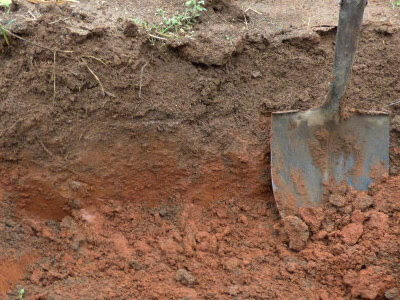 |
| Shovel included for size comparison. I tried to get a cat to volunteer for that, but for some reason none of them were interested in posing in a ditch. |
The soil in my garden is classified as cecil sandy loam. It, along with the other cecil soil types, are typical for my part of the country. This soil type has a light brown sandy loam topsoil and a red clay subsoil. Diagrammed, it looks like this ⬇
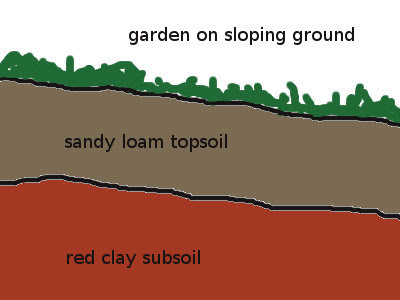 |
| The degree of topsoil darkness is an indicator of the amount organic matter present. The red in my subsoil is from iron. |
In the garden, my topsoil is typically about four to six inches in depth. Being mostly sand, it doesn’t retain moisture very well. Water drains quickly and the soil dries out quickly. It has just enough silt and clay so that it dries rock-hard during drought-like conditions.
When it rains, the topsoil quickly becomes saturated and water drains down to the clay subsoil. The clay absorbs some of the rainwater, but because my garden is on a gentle slope, the rest is drained down to the bottom of the garden.
During prolonged periods of rain it’s a big muddy puddle down there and it retains water for a long time. We discovered this by accident our first winter here. We wanted to plant an almond tree at the bottom of the garden and hit water while digging the hole. This wasn’t a tree that liked having wet feet, so we planted it elsewhere. At the time I didn’t understand what was going on, but after researching and observing, I see the patterns and the problems and want to take positive action to solve them.
The flip side is that the top of the garden dries out very quickly. It seemed to me that double-dug beds would be a good way to harvest more rainwater to benefit the summer garden.
Here’s what I’ve been doing. It starts by hand digging a trench about two shovelfuls deep. The first shoveling removes the topsoil, which is set to the side. The second shoveling removes a layer of clay, which goes into a separate pile to be used elsewhere.
Unlike my swale, which was filled only with logs, branches, bark, and corn cobs (no soil), this trench is filled with layers of rotted wood and bark, biomass, compost, and topsoil. I’m also adding dolomitic limestone and soft rock phosphorous because my soil is poor in those two minerals.
Warm weather planting is upon us, so that’s the next step.
Now when it rains my double-dug bed should catch and retain some of the subsoil runoff.
Will it work? Shortly after I took the photo at the top of this blog post it rained. One and a half inches later, my little trench had collected and was holding four inches of rain runoff.
Of course, once the trench is filled in it won’t hold this much, but between that trench and the organic matter I’m adding, this should do much to help my poor garden during dry spells.
One last comment, this plan won’t work in all types of soil. The particulars of my cecil soil generously facilitate it. Plus, in addition to rainwater catchment, double digging adds much needed organic matter to my soil in a way that should keep it productive for many years to come. Additional soil building and nutrients will be added as topdressed compost and mulch, where rain can deliver them to the roots as nature intended. No more hitting the clay and washing down the hill! Also, I have to admit for some renewed hope for root crops as well. Things like carrots and mangels were never able to penetrate that heavy clay subsoil and have been stunted for me. I’m counting more room for good root growth as another plus.
Speaking of soil types, this might be the time to do a quick plug for my little eBook, How-To Home Soil Tests: 10 DIY tests for texture, pH, drainage, earthworms & more. Click the link or the book cover to learn what it contains and where to find it. These are the same tests I used to learn about my own soil! All of them are easy, inexpensive ways for learning more about your own soil, including tests and charts for everything listed in the subtitle, plus how to read your soil color and weeds.
I’ve only just begun this project and don’t anticipate having all my rows double dug before it’s time to plant this year. It will be something I’ll just keep working on for awhile to come.
Source: http://www.5acresandadream.com/2017/04/double-digging-for-rainwater-collection.html



